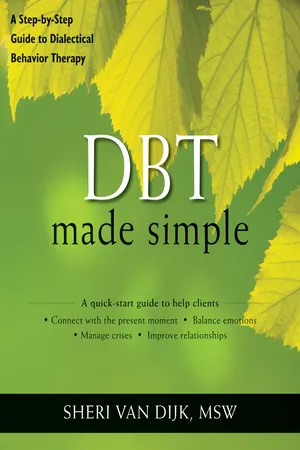About this book
Originally developed for the treatment of borderline personality disorder, dialectical behavior therapy, or DBT, has rapidly become one of the most popular and most effective treatments for all mental health conditions rooted in out-of-control emotions. However, there are limited resources for psychologists seeking to use DBT skills with individual clients. In the tradition of ACT Made Simple, DBT Made Simple provides clinicians with everything they need to know to start using DBT in the therapy room.
The first part of this book briefly covers the theory and research behind DBT and explains how DBT differs from traditional cognitive behavioral therapy approaches. The second part focuses on strategies professionals can use in individual client sessions, while the third section teaches the four skills modules that form the backbone of DBT: core mindfulness, distress tolerance, emotion regulation, and interpersonal effectiveness. The book includes handouts, case examples, and example therapist-client dialogue—everything clinicians need to equip their clients with these effective and life-changing skills.
Frequently asked questions
- Essential is ideal for learners and professionals who enjoy exploring a wide range of subjects. Access the Essential Library with 800,000+ trusted titles and best-sellers across business, personal growth, and the humanities. Includes unlimited reading time and Standard Read Aloud voice.
- Complete: Perfect for advanced learners and researchers needing full, unrestricted access. Unlock 1.4M+ books across hundreds of subjects, including academic and specialized titles. The Complete Plan also includes advanced features like Premium Read Aloud and Research Assistant.
Please note we cannot support devices running on iOS 13 and Android 7 or earlier. Learn more about using the app.
Information
Table of contents
- Contents
- Acknowledgments
- Introduction: What to Expect
- The Basics of DBT
- Preparing for the Individual Session: What You Need to Know
- The “B” in DBT: What You Need to Know about Behavior Theory
- DBT Strategies for the Individual Session
- Introducing Clients to Mindfulness
- Additional Skills for Mindfulness
- Helping Clients Reduce Emotional Reactivity
- Helping Clients Survive a Crisis: Distress Tolerance Skills
- What Clients Need to Know about Emotions
- Skills to Help Clients Regulate Emotions: Reducing Painful Emotions
- Skills to Help Clients Regulate Emotions: Increasing Positive Emotions
- Helping Clients Become More Effective in Relationships
- Conclusion: Putting It All Together
- References
